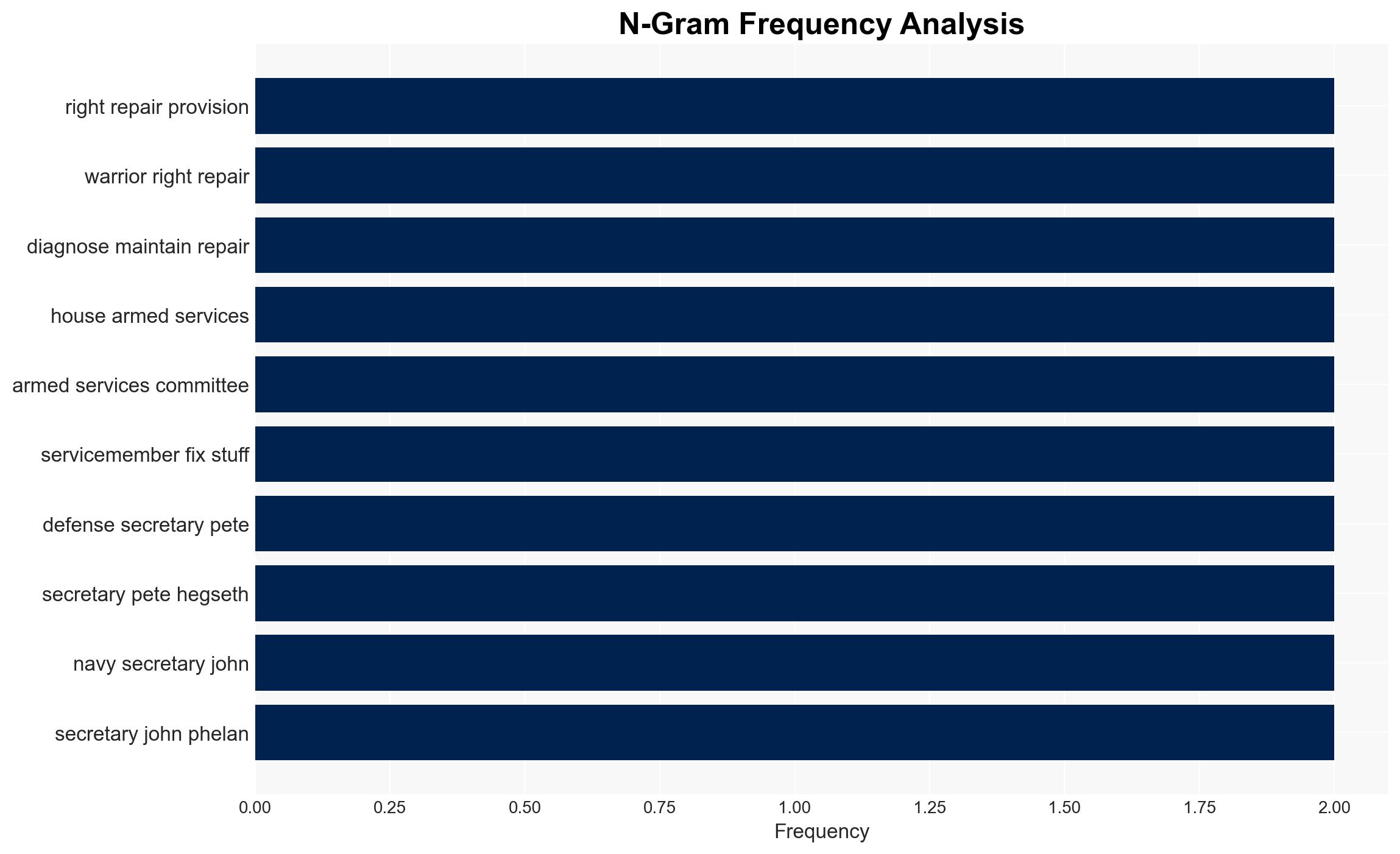US Military Seeks Equipment Repair Autonomy Amid Resistance from Defense Contractors
Published on: 2025-11-26
AI-powered OSINT brief from verified open sources. Automated NLP signal extraction with human verification. See our Methodology and Why WorldWideWatchers.
Intelligence Report: The US Military Wants to Fix Its Own Equipment Defense Contractors Are Trying to Shoot That Down
1. BLUF (Bottom Line Up Front)
The ongoing debate over the right-to-repair provisions in the National Defense Authorization Act (NDAA) reveals a significant conflict between the US military’s operational needs and defense contractors’ business interests. The military seeks to empower service members to repair equipment in the field, while contractors resist, fearing loss of revenue. This issue affects military readiness and contractor profits, with moderate confidence that the military’s position may gain traction due to bipartisan support.
2. Competing Hypotheses
- Hypothesis A: The right-to-repair provision will be included in the final NDAA, enabling military personnel to repair equipment independently. This is supported by bipartisan support and advocacy from military leaders. However, the strong lobbying by defense contractors presents a key uncertainty.
- Hypothesis B: The right-to-repair provision will be excluded from the final NDAA due to successful lobbying by defense contractors. This is supported by historical precedence of contractor influence and the economic interests at stake for contractors. However, the current political climate and bipartisan support for reform contradict this.
- Assessment: Hypothesis A is currently better supported due to broad bipartisan backing and military advocacy. Key indicators that could shift this judgment include changes in congressional support or intensified lobbying efforts by contractors.
3. Key Assumptions and Red Flags
- Assumptions: The military’s operational needs will continue to prioritize repairability; bipartisan support will remain steady; defense contractors will not significantly alter their lobbying strategies.
- Information Gaps: Specific details on the lobbying strategies of defense contractors and the extent of congressional support for the right-to-repair provision.
- Bias & Deception Risks: Potential bias from sources advocating for either side; risk of misinformation from lobbying groups aiming to sway public and legislative opinion.
4. Implications and Strategic Risks
The resolution of this issue could significantly impact military readiness and contractor business models. The outcome will likely influence future defense procurement and maintenance strategies.
- Political / Geopolitical: Potential shifts in defense policy and procurement practices; influence on US defense posture and alliances.
- Security / Counter-Terrorism: Improved repair capabilities could enhance operational readiness and response times.
- Cyber / Information Space: Increased repair capabilities may necessitate enhanced cybersecurity measures to protect repair data and processes.
- Economic / Social: Possible economic impact on defense contractors; potential cost savings for the military and taxpayers.
5. Recommendations and Outlook
- Immediate Actions (0–30 days): Monitor congressional proceedings and lobbying activities; engage with stakeholders to assess support levels.
- Medium-Term Posture (1–12 months): Develop contingency plans for both outcomes; strengthen partnerships with stakeholders supporting repairability.
- Scenario Outlook:
- Best Case: Right-to-repair provision passes, enhancing military readiness.
- Worst Case: Provision is dropped, leading to increased dependency on contractors.
- Most Likely: Provision passes with some concessions to contractors, balancing interests.
6. Key Individuals and Entities
- Senator Elizabeth Warren
- Representative Mike Rogers
- Defense Secretary Pete Hegseth
- Navy Secretary John Phelan
- Defense contractors (not specifically named)
7. Thematic Tags
Structured Analytic Techniques Applied
- Cognitive Bias Stress Test: Expose and correct potential biases in assessments through red-teaming and structured challenge.
- Bayesian Scenario Modeling: Use probabilistic forecasting for conflict trajectories or escalation likelihood.
- Network Influence Mapping: Map relationships between state and non-state actors for impact estimation.
Explore more:
National Security Threats Briefs ·
Daily Summary ·
Support us





